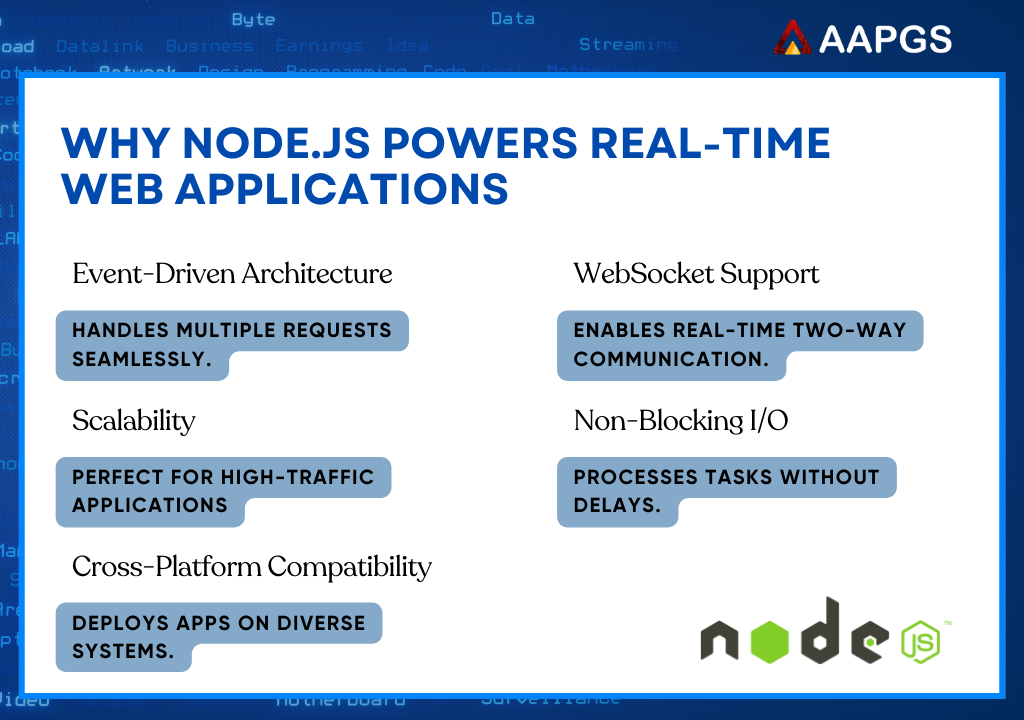Real-time web applications have become essential in today’s interconnected world, enabling instant communication, live updates, and dynamic user interactions. From chat apps and online gaming to live-streaming platforms, real-time applications dominate the digital landscape.
Enter Node.js, a powerful JavaScript runtime environment that’s tailor-made for real-time web app development. Its event-driven architecture, non-blocking I/O model, and native WebSocket support make it the ideal choice for modern developers.
In this blog, we’ll explore why Node.js stands out for building real-time web applications and how it addresses the demands of today’s digital age.
Why Node.js is Perfect for Real-Time Applications
1. Event-Driven Architecture
Node.js is built on an event-driven architecture, which means it handles multiple simultaneous requests efficiently. This approach is ideal for real-time apps that require immediate response and interaction, such as messaging platforms or online gaming.
- How it works: Instead of waiting for one request to complete, Node.js moves on to the next, ensuring faster processing.
- Benefit: Reduced latency and better performance under high user loads.
2. WebSocket Support
Real-time apps require two-way communication between the server and client. Node.js, with its built-in WebSocket support, enables seamless communication.
- What WebSocket does: Creates a persistent connection, allowing data to flow continuously without repeatedly polling the server.
- Use Case: Live chat systems like Slack or gaming platforms with instant user interaction.
3. Non-Blocking I/O Model
Node.js uses a non-blocking, asynchronous I/O model, which processes multiple tasks simultaneously without delays.
- Advantage: Prevents server crashes or slowdowns during high-traffic periods.
- Applications: Stock trading platforms, live sports score updates, and collaborative tools like Google Docs.
- Scalability for Growing Demands
Node.js is designed to handle high scalability, making it perfect for applications with growing user bases.
- Horizontal Scalability: Add more servers to manage increasing traffic.
- Node.js Clusters: Distribute tasks across multiple CPU cores for maximum efficiency.
- Example: Streaming services like Netflix use Node.js to manage millions of users concurrently.
5. Cross-Platform Compatibility
Node.js supports cross-platform development, allowing developers to build applications that run seamlessly on different operating systems.
- Benefit: Reduced development time and costs.
- Real-Life Example: A single Node.js app can serve desktop, mobile, and web users without additional codebases.
6. Large Ecosystem of Libraries
Node.js has a vast ecosystem of libraries and frameworks available through npm (Node Package Manager). Developers can access pre-built modules for real-time functionalities like chat, notifications, or analytics.
- Popular Libraries:
- Socket.IO: Simplifies WebSocket implementation.
- Express: Streamlines server-side coding.
- PM2: Manages app performance and uptime.
Node.js Real-Time Application Use Cases
1. Messaging Apps
Applications like WhatsApp, Telegram, and Slack rely on real-time communication. Node.js ensures instant message delivery and seamless synchronization.
2. Online Gaming Platforms
Real-time interaction is critical in gaming. Node.js enables fast updates, player matchmaking, and in-game chat.
3. Collaborative Tools
Tools like Google Docs and Trello depend on Node.js to ensure smooth real-time collaboration across users.
4. Live Streaming Services
Node.js powers video and audio streaming platforms, ensuring uninterrupted viewing experiences with real-time updates.
5. IoT Applications
Internet of Things (IoT) devices use Node.js to handle data streams and instant updates between devices.

How to Build Real-Time Applications with Node.js
Step 1: Set Up Node.js Environment
Install Node.js and necessary libraries like Express and Socket.IO to begin your project.
Step 2: Use WebSocket for Communication
Enable real-time data flow between the client and server using WebSocket or frameworks like Socket.IO.
Step 3: Implement Data Handling
Use asynchronous functions to handle multiple data streams without delays or crashes.
Step 4: Optimize for Scalability
Leverage Node.js clusters and horizontal scaling to ensure your app can handle growing traffic.
Step 5: Test and Deploy
Run thorough tests using tools like Mocha or Chai and deploy on platforms like AWS or Azure for high availability.
Benefits of Using Node.js for Real-Time Apps
- Speed: Fast response times for user interactions.
- Efficiency: Handles high concurrency without bottlenecks.
- Cost-Effectiveness: Single language (JavaScript) for both front-end and back-end.
- Flexibility: Scalable solutions for apps of any size.
- Community Support: A vast, active community ensures continuous innovation.
Conclusion
Node.js has become the backbone of real-time web application development, offering unparalleled speed, scalability, and performance. Its event-driven architecture, WebSocket support, and non-blocking I/O make it the go-to solution for today’s dynamic requirements.
Whether you’re building a messaging app, gaming platform, or collaborative tool, Node.js ensures your application meets user expectations for real-time interactions.
.png)